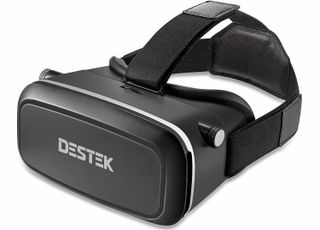Destek VR Headset Review: Ready for AR, Too
The Destek VR headset offers a comfortable design, good image quality and augmented-reality capabilities, but it has some unfortunate design flaws.
Why you can trust Tom's Guide

The Destek ($35.99) is a VR headset that offers the somewhat unique ability to remove the front panel and use it for augmented-reality (AR) apps as well. Now for most people, this is probably going to conjure up visions of Pokemon Go, but there are much more immersive AR experiences out there, like ViewR, that are designed to work within a headset and overlay helpful information about your world, creating a mixed-reality scenario. Companies like Apple and Microsoft have continually pushed the notion that AR has a stronger future than VR, so if you want a headset that can do both, you have your answer in the Destek.
Design
The Destek doesn’t stray too far from the basic design that's shared by most inexpensive virtual-reality headsets. It has a plastic body with a foam-padded back that's covered in leather and a two-part head strap. However, it executes effectively on that design and offers a couple additional touches to help set it apart. Controls to adjust the focal and pupil distance are at the temple area and top of the headset, respectively, granting easy access to users wanting to make adjustments on the fly.
I really appreciate the ability to remove a section of the magnetically attached front panel. This sets the stage for you to use the headset for AR apps that require that your smartphone’s camera be exposed. And while we didn’t find heat to be an issue with this headset, the ability to remove that section would alleviate any such problems, should they arise.
My biggest complaint with the Destek is the clamp mechanism for holding your phone. The position of the grips is such that you can sometimes inadvertently trigger the power or volume buttons. Shifting the phone slightly or flipping it over will remedy the problem, but it can be irritating during setup. Light leakage via the top of the device was also an issue, albeit a minor one.
Setup
Similar to competing mobile VR headsets, getting started with the Destek VR is as simple as removing the front panel and snapping it into the phone-shaped depression. Just be sure to start the app or game you're planning on using first.
Comfort
At 12.5 ounces, the Destek isn’t one of the lightest VR headsets out there, especially compared to the Magiove, which weighs a mere 10.6 ounces. However, due to proper weight distribution, it is very well-balanced. This sets a solid foundation for comfort, avoiding the front-heavy pull found on many cheap headsets.
The head strap uses the basic design shared by most of the cheap VR headsets, with side and top straps that are adjusted with velcro and a faux-leather piece at the back. The straps are noticeably wider than most of the others, however, which contributes to the headset's overall comfort.

During longer gaming or viewing sessions, the cushioned faux leather that rests against your face isn’t quite as pleasant as the perforated design found on the Magiove or ETVR headsets. We noticed some heat being trapped with the Destek, but it isn’t a major concern.
Optics
The image quality with the Destek was excellent. Once focused properly, it was crystal-clear without any obvious distortion, and color reproduction seemed faithful in the Cedar Point VR roller coaster simulation. There can be some light leak at the top of the headset, however, which is worth considering if you are planning to consistently use your VR headset in well-lit environments.
MORE: Best VR Headsets
The field of view was approximately 83 degrees, which is competitive in this price range, but far short of the approximately 100 degrees on the Google Daydream View and Samsung Gear VR.
An included lens cloth helps keep your lens clear of accumulations of dust and debris.
Audio
Similar to most mobile VR headsets, the Destek lacks integrated audio, forcing you to rely on your smartphone speakers or a trusty set of headphones. The headset features cutouts along each side of the front plate that will either help direct the sound from the speakers outward or allow you to run a 3.5-millimeter plug for wired headphones.
Apps, Games, Experiences
The Destek isn’t "Work with Cardboard"-compatible because it lacks the necessary button that's used to trigger some events in Google Cardboard apps. However, if you do a quick search for VR content in Google Play or the iOS App Store, the Destek will work just fine with the vast majority of experiences available, including Lamper VR: Firefly Rescue, Cardboard Camera or Minos Starfighter VR.
Peripherals
The Destek includes a small Bluetooth gamepad that is designed to attach to a keychain to ensure that you have it with you at all times. At 0.8 ounces, the weight is negligible at best. And while it's obvious the diminutive device isn’t taking the place of a full-size gamepad, it does a serviceable job at improving the mobile gaming experience.
MORE: Google Cardboard Review: Better Than Nothing
The 3.5 x 1.5-inch gamepad has a single analog stick along with select, start, A, B, X and Y buttons. I had no difficulty pairing the gamepad with my Android phone (it's not compatible with iOS), and the controls were responsive in each game that I tested. While I wouldn’t hinge my decision on the inclusion of this gamepad, it is definitely a bonus, and the Destek's slightly larger size, when compared to the gamepad that's included with the Magiove headset, makes this much more comfortable to use.
Bottom Line
The Destek is a solid offering in the cheap VR headset category, with a comfortable design, quick focusing and the added flexibility to operate as an AR headset. The included gamepad is a much-appreciated extra and helps to round out the package.
The slight light leakage we experienced — and sometimes-frustrating clamp mechanism — kept the Destek from getting our top marks, but in the crowded budget-VR field, it is still a standout. If you don’t need AR support, the cheaper Magiove is the better value.
Sign up to get the BEST of Tom’s Guide direct to your inbox.
Upgrade your life with a daily dose of the biggest tech news, lifestyle hacks and our curated analysis. Be the first to know about cutting-edge gadgets and the hottest deals.
A self-professed "wearer of wearables," Sean Riley is a Senior Writer for Laptop Mag who has been covering tech for more than a decade. He specializes in covering phones and, of course, wearable tech, but has also written about tablets, VR, laptops, and smart home devices, to name but a few. His articles have also appeared in Tom's Guide, TechTarget, Phandroid, and more.

